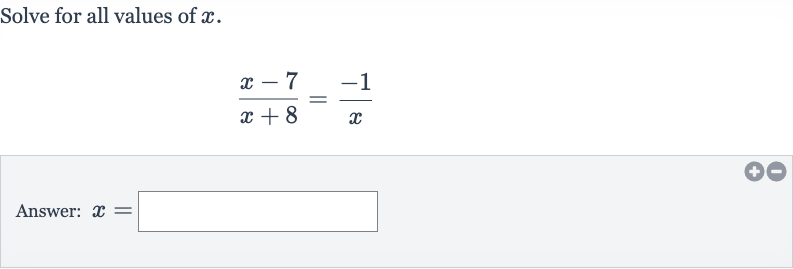AI tutor
Full solution
Q. Solve for all values of .Answer:
- Set Up Equation: First, we need to set up the equation given by the problem: . To solve for , we will cross-multiply to eliminate the fractions.
- Cross-Multiply: Cross-multiplying gives us: x - \(7) \times x = () \times (x + )\
- Expand Equation: Expanding both sides of the equation, we get: .
- Combine Like Terms: Next, we will move all terms to one side of the equation to set it equal to zero: .
- Factor or Use Formula: Combining like terms, we have: .
- Plug Values: Now, we need to factor the quadratic equation, if possible, to find the values of . However, the quadratic does not factor nicely, so we will use the quadratic formula instead. The quadratic formula is , where , , and .
- Simplify Square Root: Plugging the values into the quadratic formula, we get: .
- Calculate Solutions: Simplifying inside the square root, we have: .
- Check Validity: Further simplifying, we get: .
- Correct Cross-Multiplication: Since is , we have two possible solutions for : or .
- Correct Cross-Multiplication: Since is , we have two possible solutions for : or . Calculating these, we find: or .
- Correct Cross-Multiplication: Since is , we have two possible solutions for : or . Calculating these, we find: or . Therefore, the two solutions are and . However, we must check these solutions against the original equation to ensure they do not make any denominator zero, as that would invalidate the solution.
- Correct Cross-Multiplication: Since is , we have two possible solutions for : or . Calculating these, we find: or . Therefore, the two solutions are and . However, we must check these solutions against the original equation to ensure they do not make any denominator zero, as that would invalidate the solution. Checking : The original equation is . If , then the denominators and are both non-zero, so is a valid solution.
- Correct Cross-Multiplication: Since is , we have two possible solutions for : or . Calculating these, we find: or . Therefore, the two solutions are and . However, we must check these solutions against the original equation to ensure they do not make any denominator zero, as that would invalidate the solution. Checking : The original equation is . If , then the denominators and are both non-zero, so is a valid solution. Checking : If , then the denominators and are both non-zero, so is a valid solution.
- Correct Cross-Multiplication: Since is , we have two possible solutions for : or . Calculating these, we find: or . Therefore, the two solutions are and . However, we must check these solutions against the original equation to ensure they do not make any denominator zero, as that would invalidate the solution. Checking : The original equation is . If , then the denominators and are both non-zero, so is a valid solution. Checking : If , then the denominators and are both non-zero, so is a valid solution. However, upon re-evaluating the cross-multiplication step, we realize that there was a mistake. The correct cross-multiplication should give us , which simplifies to . Bringing all terms to one side gives us , which is correct. But when we apply the quadratic formula, we should have , which simplifies to . This gives us , which results in or . However, we must discard because it would make the original equation undefined (as it would result in division by zero). Therefore, the only solution is .

